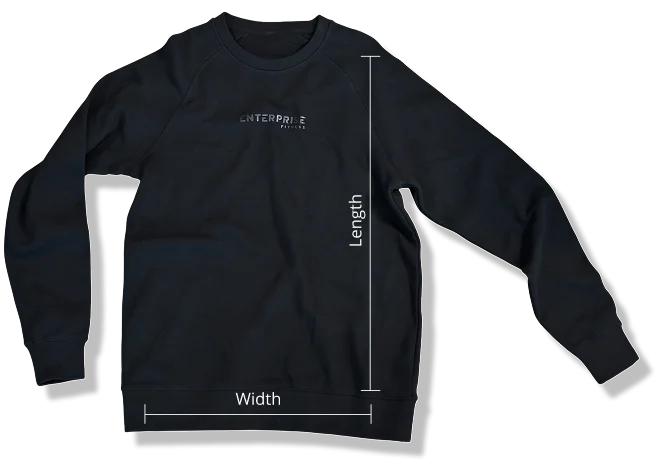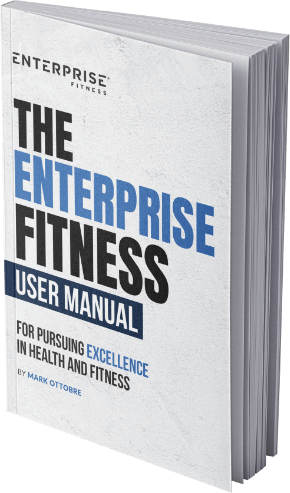Melbourne's Leading & Most In-Demand Personal Training Studio
Find out exactly how much you need to train in 60 seconds
per muscle group per week
At Enterprise Fitness,
we build plans around your body, schedule and goals.
Training volume is the total amount of work you perform during your resistance training sessions, typically measured in sets per muscle group per week.
For example:
Research shows that total weekly volume is more important than how that volume is distributed. A 2016 meta-analysis by Brad Schoenfeld found that training a muscle group 2x per week produced superior hypertrophy compared to 1x per week when total volume was equated.
Key principle: It’s not about crushing a muscle in one session. It’s about providing adequate weekly stimulus while managing fatigue.
Example:
Optimal approach: Distribute your weekly volume across 2-3 sessions per muscle group to maximize recovery and adaptation.
Training volume follows a dose-response curve for muscle hypertrophy:
A 2017 systematic review by Schoenfeld, Ogborn, and Krieger analyzed 15 studies and found a clear dose-response relationship between weekly sets and muscle growth, with higher volumes generally producing greater hypertrophy up to a certain point.
Dr. Mike Israetel of Renaissance Periodization identified four key volume thresholds:
While higher volumes can produce more growth, there’s a point of diminishing returns. Training beyond your MRV can result in:
The goal: Find your personal sweet spot (MAV) where you’re training hard enough to grow but not so hard you can’t recover.
Your base volume depends primarily on training experience:
Your ability to recover from training depends on multiple factors:
Research shows sleep deprivation impairs muscle protein synthesis, increases cortisol, and reduces recovery capacity. No amount of training volume can overcome chronic sleep deprivation.
Recovery capacity decreases with age, requiring more intelligent volume management.
Research suggests women recover faster from training due to hormonal differences, though individual variation is large.
Example Calculation:
Profile:
Calculation:
Use the calculator above to get your personalized recommendation based on your specific situation.
Recommended Volume: 8-15 sets per muscle per week
Why this works: Beginners are extremely sensitive to training stimulus. Your nervous system is learning movement patterns, and your muscles respond to minimal volume.
Recommended Volume: 10-18 sets per muscle per week
Why this works: You’ve exhausted “beginner gains” and need more volume to continue progressing. Your work capacity has increased, and you can handle more training stress.
Recommended Volume: 12-22 sets per muscle per week
Why this works: Advanced trainees have significant muscle mass and training adaptation. You need higher volumes to continue stimulating growth, but you also need to manage fatigue carefully.
Recommended Volume: 14-26+ sets per muscle per week
Why this works: Elite lifters have maximized neural adaptations and have significant muscle mass. Higher volumes may be necessary to continue progressing, but recovery becomes the limiting factor.
The reality for advanced lifters: At this level, adding more volume rarely solves plateaus. Exercise selection, technique refinement, nutrition precision, and recovery optimization matter more than simply doing more sets.
The problem: Beginners see advanced bodybuilders doing 20+ sets per muscle and think they need the same volume.
Why it fails:
The fix: Start with the minimum effective volume for your experience level. Add sets gradually (1-2 per month) as you adapt.
The problem: Using the same volume year after year, expecting different results.
Why it fails:
The fix: Progressively increase volume over time as your work capacity improves. Use periodization to cycle between lower and higher volumes.
The problem: Focusing only on training while neglecting sleep, nutrition, and stress management.
Why it fails:
The fix: Most sets should be taken to 2-3 reps in reserve (RIR). Save failure training for:
The problem: Believing every set must be taken to absolute muscular failure to be effective.
Why it fails:
The fix: Treat recovery as seriously as training. Prioritize:
The problem: Chasing muscle soreness as a metric of workout quality.
Why it fails:
The fix: Track progressive overload (strength increases) instead of soreness. Slight soreness is normal, but debilitating soreness means too much volume or poor recovery.
The problem: Following the training programs of professional bodybuilders or powerlifters.
Why it fails:
The fix: Follow principles appropriate for YOUR experience level and recovery capacity. Elite programs are designed for elite athletes.
The problem: Training without recording sets, reps, or weight used.
Why it fails:
The fix: Keep a training log. Track:
The principle: Gradually increase training volume over weeks or months to continue driving adaptation.
How to implement: Start at your MEV and add 1-2 sets per muscle group every 1-2 weeks until you reach your MAV or start experiencing recovery issues.
Example progression (intermediate chest training):
Increase training volume when:
Decrease training volume when:
What is a deload? A planned reduction in training volume or intensity to allow for recovery and resensitization to training stimulus.
When to deload:
How to deload:
Deload duration: Typically 3-7 days
Linear periodization: Gradually increase volume week by week within a mesocycle (4-8 weeks), then deload.
Example:
Undulating periodization: Vary volume workout to workout or week to week.
Example:
Block periodization: Focus on different qualities in different training blocks.
Example:
Not all muscle groups are created equal. Larger muscles with more mass generally require more volume, while smaller muscles need less.
Large Muscle Groups (Higher Volume)
Medium Muscle Groups (Moderate Volume)
Small Muscle Groups (Lower Volume)
Back Training: The back is composed of multiple muscles (lats, traps, rhomboids, erectors). Total back volume of 14-22 sets should be distributed across:
Leg Training: Legs are the largest muscle group and can handle significant volume:
Shoulder Training: Shoulders get indirect volume from pressing movements:
Arm Training: Arms receive significant indirect volume:
Key principle: Higher weekly volumes should be distributed across more frequent sessions.
Why frequency matters:
Low Volume (6-10 sets per week):
Moderate Volume (10-16 sets per week):
High Volume (16-22 sets per week):
Very High Volume (22+ sets per week):
Full Body (3-4x per week):
Upper/Lower (4-6x per week):
Push/Pull/Legs (6x per week):
Body Part Split (5-6x per week):
Optimal volume: 10-20 sets per muscle per week for most people
Hypertrophy principles:
Progression strategy: Start at 10-12 sets per week and gradually increase to 16-20 sets over 6-8 weeks, then deload and repeat.
Example progression:
Optimal volume: 8-15 sets per muscle per week
Strength principles:
Why lower volume? Strength training is neurally demanding. The primary adaptation is improving nervous system efficiency, not adding muscle mass. Higher volumes would create too much fatigue and limit intensity.
Typical strength program:
Optimal volume: Maintain muscle-building volumes or slightly reduce (10-18 sets per week)
Fat loss principles:
Common mistake: Adding massive amounts of cardio or training volume when cutting. This:
The right approach: Maintain your training volume, create a moderate caloric deficit (300-500 calories), and prioritize protein intake (2.0-2.4g/kg body weight).
Optimal volume: 6-10 sets per muscle per week
Maintenance principles:
Research support: Studies show that muscle mass can be maintained with approximately 1/3 of the volume used to build it, as long as intensity is preserved.
Schoenfeld, Ogborn & Krieger (2017) – Dose-Response Relationship
Schoenfeld et al. (2019) – High Volume Training in Trained Men
Schoenfeld, Ogborn & Krieger (2016) – Training Frequency
Krieger (2010) – Single vs Multiple Sets
Radaelli et al. (2015) – Very High Volume Study
Hackett et al. (2013) – Volume and Hormonal Response
Heaselgrave et al. (2019) – Dose-Response in Trained Individuals
Dattilo et al. (2011) – Sleep and Muscle Recovery
Fullagar et al. (2015) – Sleep Loss and Exercise Performance
Stults-Kolehmainen & Sinha (2014) – Stress and Exercise
Stec et al. (2017) – Aging and Training
Ansdell et al. (2020) – Sex Differences in Fatigability

Discover how real people turned things around. The Enterprise Diet reveals clear, no-nonsense strategies to help you transform your body and finally reach your goals, for good.
*300+ pages of life-changing advice
It depends on your training experience:
Start at the lower end of your range and gradually increase volume over time. Use the calculator above to get your personalized recommendation.
Yes. Training beyond your Maximum Recoverable Volume (MRV) leads to:
Signs you’re doing too much volume:
3 sets per exercise can build muscle, but total weekly volume matters more.
Example:
Most research suggests 10+ sets per muscle per week for optimal growth.
No. Larger muscle groups generally need more volume:
Increase volume gradually:
LIFE CHAnGING TRANSFORMATIONS
Chat with a coach for free—no pressure, just a plan built around you.
Our private personal training studio in Richmond has everything you need to help you begin your fitness journey, transform your body and level up your fitness with a program, nutrition and supplement
plan created exclusively for you.
ARE YOU READY TO CHANGE YOUR BODY, HEALTH, AND ULTIMATELY YOUR LIFE?

Get an exclusive look at the Enterprise Diet with a FREE chapter.
"*" indicates required fields
We will only send you awesome stuff

Fuel your results with our flexible food guide. Whether you’re bulking, shredding, or maintaining, this smart list keeps it simple and effective.
We will only send you awesome stuff
Enterprise Fitness – Data collection and privacy policy
Thank you for visiting Enterprise Fitness, located in Richmond, Victoria.
We respect and protect the privacy of our website users and clients.
We act in accordance the Privacy Act 1988 (Cth).
This policy tells you how we collect and use information.
Data Collection
We only collect the Personal Information or additional information necessary to provide the service or goods you require. “Personal Information” means any information from which your identity is known or can be reasonably ascertained.
Website
We do not collect Personal Information about you when you visit our website.
You can use the website without telling us who you are or revealing other Personal Information.
If you send us a contact or feedback form we will collect Personal Information. If you contact us we will collect the email address you nominate and any other identifying information you provide, such as a name or phone number. You consent to us contacting you by providing that Personal Information.
Clients
We also collect Personal Information about you when you commence training with us as a client or when you make a purchase through our website. This may include additional information about you, such as your training history, health etc.
When we collect Personal Information or additional information we will treat it in accordance with our privacy policy.
Privacy policy
Access to your Personal Information or additional information is restricted to staff who need it to provide benefits or services to you.
We train our staff about the importance of confidentiality and maintaining the privacy and security of your information.
We do not share Personal Information with other entities unless you request us to, we ask you first or required by law to share.
We may share anonymised data, such as your server location, with other entities.
We collect this data by using Cookies (which are small files that are stored on your computer or mobile device). We use Cookies to record how many times you have visited our website and which parts of our website you have visited. Cookies can be used to provide you with information that you are interested in. By using our website, you consent to the processing of data about you by Google in the the way described in Google’s Privacy Policy.
If you ask us about an issue that needs to be dealt with by another entity, we will treat your Personal Information confidentially and request any other entity to do the same. We are not responsible for what other entities do however.
How we deal with complaints and requests
You may request access to Personal Information about you that we hold. You may ask us to correct your Personal Information if it is not accurate, up-to-date or incomplete.
You may make a complaint about our handling of your Personal Information.
To protect your privacy, we will require evidence of your identity before we can give you access to information about you or change it.
You can contact us by email, or send your request or complaint to the postal address below. We undertake to respond within 30 days.
If the request or complaint will take longer to resolve, we will provide you with a date by which we expect to respond.
Contact us
Privacy Manager
Enterprise Fitness
473 Victoria Street,
Abbotsford, 3067.

Ensure your new outfit fits perfectly! Explore our size guide below to discover the ideal size for you.
| Size |
Width (cm) |
Length (cm) |
|---|---|---|
| XS | 40 | 61 |
| S | 45 | 66 |
| M | 50 | 71 |
| L | 55 | 76 |
| XL | 60 | 81 |
| XXL | 65 | 86 |
Visit Enterprise Fitness studio to claim your free copy of the book!
Get exclusive access to our video series
We will only send you awesome stuff

We will only send you awesome stuff

Get an exclusive copy of the Enterprise Fitness User Manual
We will only send you awesome stuff